Submitted:
24 June 2024
Posted:
25 June 2024
You are already at the latest version
Abstract
Keywords:
1. Introduction
2. Materials and Methods
2.1. Materials
2.2. Methods
3. Results
3.1. Interplanetary and Geomagnetic Conditions
3.2. Comparison of the Ionosonde Instruments
3.3. Comparison of the ICME- and the SIR/CIR-Driven Ionospheric Storm Cases
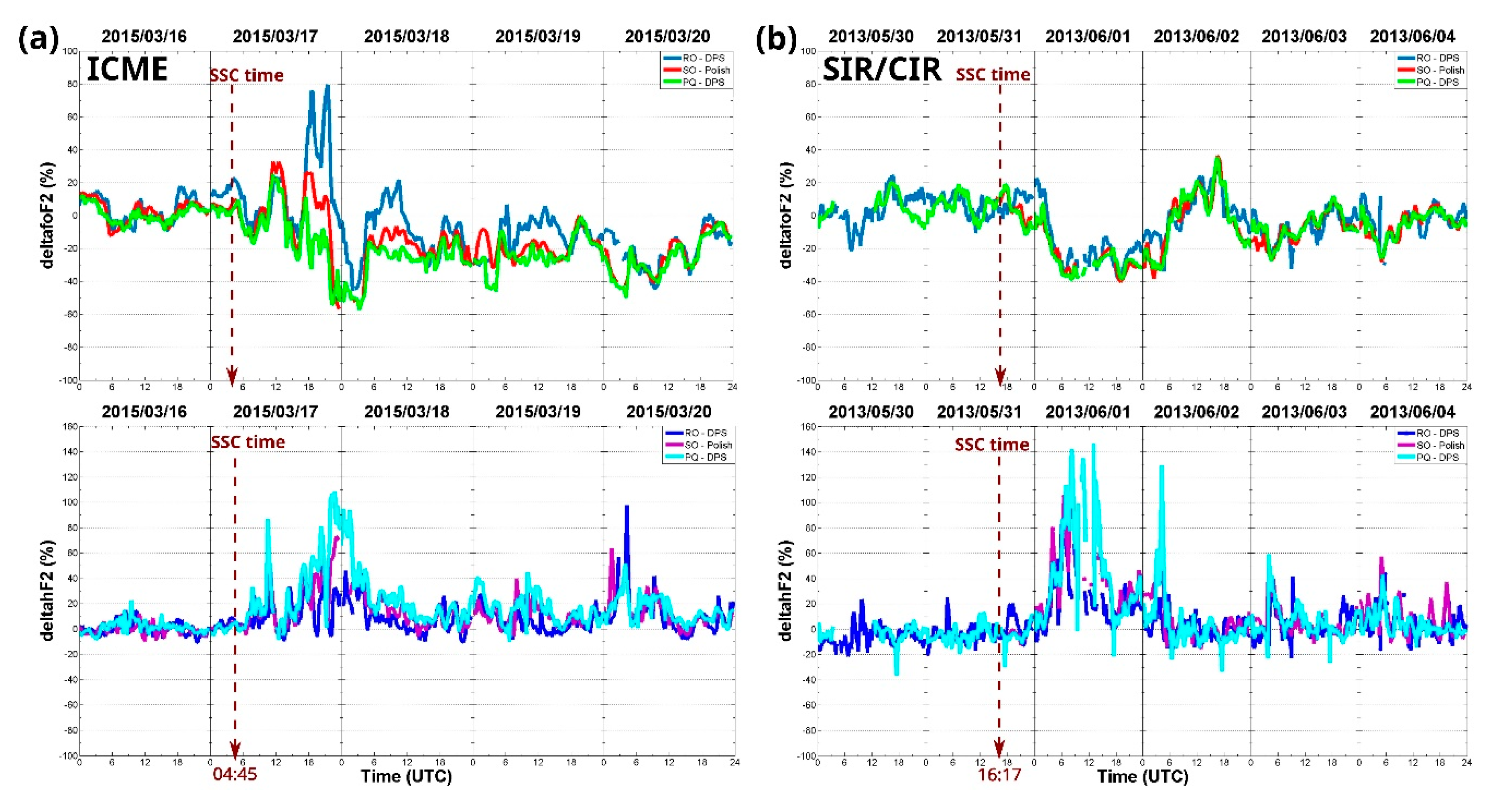
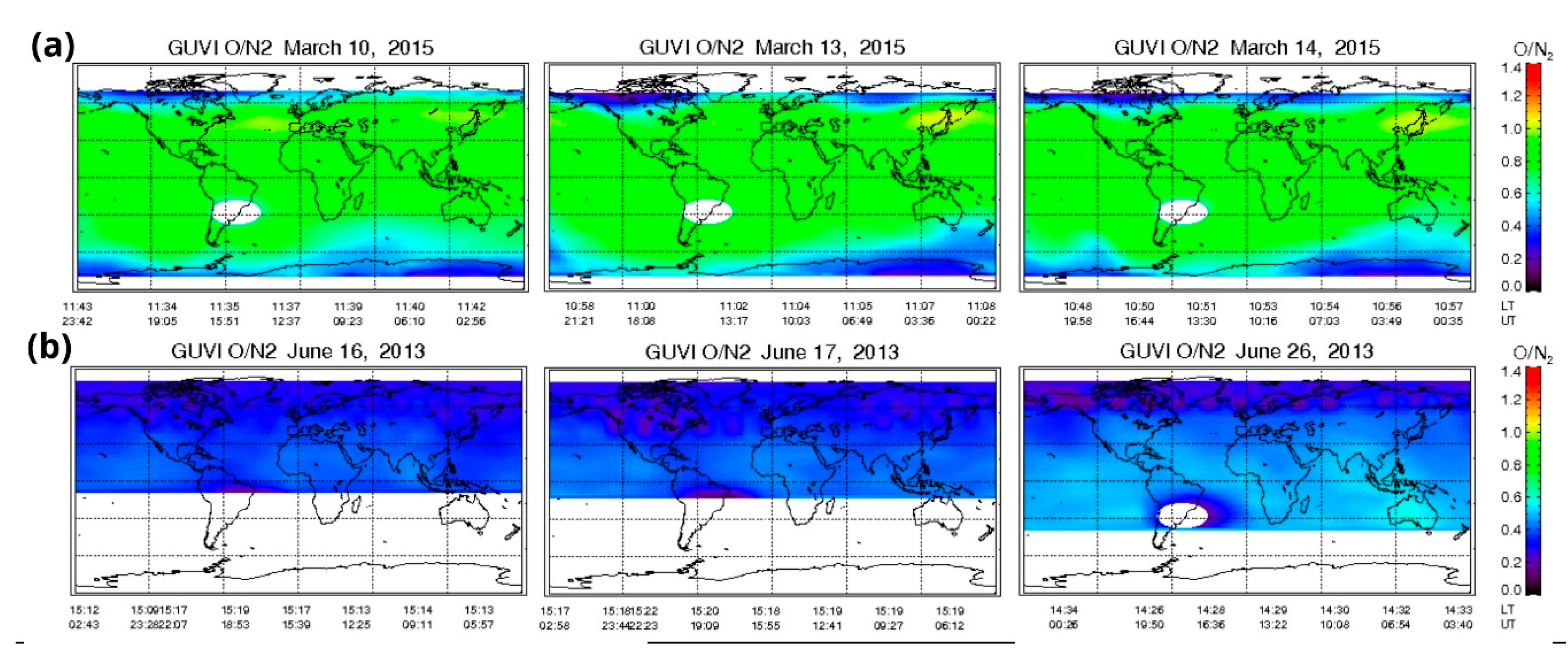
4. Discussion
5. Conclusions
- From the comparison of the data provided by the ionosondes we can conclude that the RO AIS and DPS type of ionosonde measure the same values.
- The quiet mean foF2 and h’F2 curves from each ionosonde indicate that the instrument type does not result in any noticeable differences in the data.
- Due to the SSC that characterized the ICME-driven storms a TAD is launched on 17th March, as seen in the ionospheric parameters across all analyzed stations, this phenomenon is not observed during the SIR/CIR related other geomagnetic storm.
- The electron density variations show significant latitude dependence during the main and early recovery phase of the St. Patrick’s Day storm, while there is no latitude dependence in data in the June 2013 storm. This difference may be attributed to the different seasons rather than the different drivers. During summer the background thermospheric circulation is equatorward and brings disturbed composition up to the Rome latitude, while during the St. Patrick’s Day storm the disturbed composition with a decreased [O]/[N2] ratio is locked at the latitude of Pruhonice and Sopron.
- The deltahF2 parameter shows latitude dependence only when the F2-layer is uplifting due to the storm-time processes arising from the auroral region. This is observed during the night of 17th /18th March and during the day of 01st June.
- The TIMED/GUVI decrease [O]/[N2] ratio during daytime confirms that the negative storm observed in the electron density is due to a variation in the thermospheric composition, especially for the SIR/CIR-driven event on 01st June.
- The equatorward movement of the negative ionospheric storm phase is detected with rTEC in agreement with the observed F2-layer plasma depletion during both cases. This indicates the presence of a nighttime MIT for the ICME-driven event and a daytime MIT for the SIR/CIR-driven event. For the SIR/CIR case this statement requires validation with other data sources, such as digisonde drift and satellite data.
Supplementary Materials
Author Contributions
Funding
Data Availability Statement
Acknowledgments
Conflicts of Interest
References
- N. U. Crooker and E. W. Cliver, “Postmodern view of M-regions,” J Geophys Res Space Phys, vol. 99, no. A12, pp. 23383–23390, Dec. 1994. [CrossRef]
- G. Burns, S. C. G. Burns, S. C. Solomon, W. Wang, L. Qian, Y. Zhang, and L. J. Paxton, “Daytime climatology of ionospheric NmF2 and hmF2 from COSMIC data,” J Geophys Res Space Phys, vol. 117, no. A9, p. 9315, Sep. 2012. [CrossRef]
- Y. Kamide, “Interplanetary and magnetospheric electric fields during geomagnetic storms: what is more important, steady-state fields or fluctuating fields?,” J Atmos Sol Terr Phys, vol. 63, no. 5, pp. 413–420, Mar. 2001. [CrossRef]
- D. Buresova, J. Lastovicka, P. Hejda, and J. Bochnicek, “Ionospheric disturbances under low solar activity conditions,” Advances in Space Research, vol. 54, no. 2, pp. 185–196, 2014. [CrossRef]
- G. M. Chen, J. Xu, W. Wang, J. Lei, and A. G. Burns, “A comparison of the effects of CIR- and CME-induced geomagnetic activity on thermospheric densities and spacecraft orbits: Case studies,” J Geophys Res Space Phys, vol. 117, no. A8, p. 8315, Aug. 2012. [CrossRef]
- M. H. Denton et al., “Geomagnetic storms driven by ICME- and CIR-dominated solar wind,” J Geophys Res Space Phys, vol. 111, no. A7, pp. 7–07, Jul. 2006. [CrossRef]
- B. T. Tsurutani et al., “Corotating solar wind streams and recurrent geomagnetic activity: A review,” J Geophys Res Space Phys, vol. 111, no. 7, Jul. 2006. [CrossRef]
- N. E. Turner, W. D. Cramer, S. K. Earles, and B. A. Emery, “Geoefficiency and energy partitioning in CIR-driven and CME-driven storms,” J Atmos Sol Terr Phys, vol. 71, no. 10–11, pp. 1023–1031, Jul. 2009. [CrossRef]
- B. A. Emery, I. G. Richardson, D. S. Evans, and F. J. Rich, “Solar wind structure sources and periodicities of auroral electron power over three solar cycles,” J Atmos Sol Terr Phys, vol. 71, no. 10–11, pp. 1157–1175, Jul. 2009. [CrossRef]
- R. C. Allen, G. C. Ho, L. K. Jian, G. M. Mason, S. K. Vines, and D. Lario, “Predictive Capabilities and Limitations of Stream Interaction Region Observations at Different Solar Longitudes,” Space Weather, vol. 18, no. 4, Apr. 2020. [CrossRef]
- S. T. Wadley and R. Bingham, “THE STORM TIME RESPONSE OF THE INNER MAGNETOSPHERE DURING CORONAL MASS EJECTION AND COROTATING INTERACTION REGION DRIVEN STORMS,” 2019.
- M. Mendillo and C. Narvaez, “Ionospheric storms at geophysically-equivalent sites – Part 1: Storm-time patterns for sub-auroral ionospheres,” Ann. Geophys, vol. 27, pp. 1679–1694, 2009, Accessed: Jun. 13, 2017. [Online]. Available: www.ann-geophys.net/27/1679/2009/.
- M. Mendillo and C. Narvaez, “Ionospheric storms at geophysically-equivalent sites - Part 2: Local time storm patterns for sub-auroral ionospheres,” Ann Geophys, vol. 28, no. 7, pp. 1449–1462, 2010. [CrossRef]
- Y. Chi, C. Shen, B. Luo, Y. Wang, and M. Xu, “Geoeffectiveness of Stream Interaction Regions From 1995 to 2016,” Space Weather, vol. 16, no. 12, pp. 1960–1971, Dec. 2018. [CrossRef]
- N. Gopalswamy, “Solar connections of geoeffective magnetic structures,” 2008. [CrossRef]
- H. Rishbeth and P. R. Field, “Latitude and solar-cycle patterns in the response of the ionosphere F2-layer to geomagnetic activity,” Advances in Space Research, vol. 20, no. 9, pp. 1689–1692, 1997. [CrossRef]
- G. W. Prolss, Physics of the Earth’s Space Environment: An Introduction. Springer Berlin Heidelberg, 2004. [CrossRef]
- M. J. Buonsanto, “Ionospheric storms – A review,” Space Sci Rev, vol. 88, no. 3–4, pp. 563–601, 1999. [CrossRef]
- M. Mendillo, “Storms in the ionosphere: Patterns and processes for total electron content,” Reviews of Geophysics, vol. 44, no. 4, pp. 1–47, 2006. [CrossRef]
- E. A. Kumar and S. Kumar, “Geomagnetic Storm Effect on F2-Region Ionosphere during 2012 at Low-and Mid-Latitude-Latitude Stations in the Southern Hemisphere,” Atmosphere (Basel), vol. 13, no. 3, p. 480, Mar. 2022. [CrossRef]
- D. Burešová and J. Laštovička, “Pre-storm enhancements of foF2 above Europe,” Advances in Space Research, vol. 39, no. 8, pp. 1298–1303, 2007. [CrossRef]
- A. D. Danilov and J. Lastovicka, “Effects of geomagnetic storms on the ionosphere and atmosphere,” International Journal of Geomagnetism and Aeronomy, vol. 2, no. 3, 2001.
- C. Zhai, S. Tang, W. Peng, X. Cheng, and D. Zheng, “Driver of the Positive Ionospheric Storm over the South American Sector during 4 November 2021 Geomagnetic Storm,” Remote Sensing 2023, Vol. 15, Page 111, vol. 15, no. 1, p. 111, Dec. 2022. [CrossRef]
- R. Bojilova and P. Mukhtarov, “Response of the electron density profiles to geomagnetic disturbances in January 2005,” Studia Geophysica et Geodaetica, vol. 63, no. 3, pp. 436–454, Jul. 2019. [CrossRef]
- K. A. Berényi, B. Heilig, J. Urbář, D. Kouba, Kis, and V. Barta, “Comprehensive analysis of the ionospheric response to the largest geomagnetic storms from solar cycle 24 over Europe,” Frontiers in Astronomy and Space Sciences, vol. 10, p. 1092850, Apr. 2023. [CrossRef]
- T. J. Immel and A. J. Mannucci, “Ionospheric redistribution during geomagnetic storms,” J Geophys Res Space Phys, vol. 118, no. 12, pp. 7928–7939, 2013. [CrossRef]
- E. Zuccheretti, G. Tutone, U. Sciacca, C. Bianchi, and B. James Arokiasamy, “The new AIS-INGV digital ionosonde,” ANNALS OF GEOPHYSICS, vol. 46, no. 4, 2003, Accessed: May 30, 2024. [Online]. Available: https://www.earth-prints.org/handle/2122/986.
- V. Romano, J. A. Baskaradas, F. Doumaz, M. Pezzopane, U. Sciacca, and E. Zuccheretti, “The New AIS-INGV Ionosonde at Italian Antarctic Observatory”, Accessed: May 30, 2024. [Online]. Available: https://www.earth-prints.org/handle/2122/4079.
- I. Krasheninnikov, M. Pezzopane, and C. Scotto, “Application of Autoscala to ionograms recorded by the AIS-Parus ionosonde,” Comput Geosci, vol. 36, no. 5, pp. 628–635, May 2010. [CrossRef]
- Upper atmosphere physics and radiopropagation Working Group et al., “Electronic Space Weather upper atmosphere database (eSWua) - HF data, version 1.0. Istituto Nazionale di Geofisica e Vulcanologia (INGV).
- Upper atmosphere physics and radiopropagation Working Group et al., “Electronic Space Weather upper atmosphere database (eSWua) - HF validated data (Version 1.0). Istituto Nazionale di Geofisica e Vulcanologia (INGV).
- A. B. Christensen et al., “Initial observations with the Global Ultraviolet Imager (GUVI) in the NASA TIMED satellite mission,” J Geophys Res Space Phys, vol. 108, no. A12, Dec. 2003. [CrossRef]
- G. Crowley et al., “Global thermosphere-ionosphere response to onset of 20 November 2003 magnetic storm,” J Geophys Res Space Phys, vol. 111, no. 10, Oct. 2006. [CrossRef]
- K. A. Berényi, V. Barta, and Kis, “Midlatitude ionospheric F2-layer response to eruptive solar events-caused geomagnetic disturbances over Hungary during the maximum of the solar cycle 24: A case study,” Advances in Space Research, vol. 61, no. 5, pp. 1230–1243, Mar. 2018. [CrossRef]
- V. Barta, R. Natras, V. Srećković, D. Koronczay, M. Schmidt, and D. Šulic, “Multi-instrumental investigation of the solar flares impact on the ionosphere on 05–06 December 2006,” Front Environ Sci, vol. 10, p. 1174, Aug. 2022. [CrossRef]
- J. S. R. Zhang, Y. Zhang, W. Wang, and O. P. Verkhoglyadova, “Geospace system responses to the St. Patrick’s Day storms in 2013 and 2015,” J Geophys Res Space Phys, vol. 122, no. 6, pp. 6901–6906, Jun. 2017. [CrossRef]
- Liu et al., “Profiles of ionospheric storm-enhanced density during the 17 March 2015 great storm,” J Geophys Res Space Phys, vol. 121, no. 1, pp. 727–744, Jan. 2016. [CrossRef]
- S. R. Zhang et al., “Observations of ion-neutral coupling associated with strong electrodynamic disturbances during the 2015 St. Patrick’s Day storm,” J Geophys Res Space Phys, vol. 122, no. 1, pp. 1314–1337, Jan. 2017. [CrossRef]
- C. Huang, J. Y. Xu, X. X. Zhang, D. D. Liu, W. Yuan, and G. Y. Jiang, “Mid-latitude thermospheric wind changes during the St. Patrick’s Day storm of 2015 observed by two Fabry-Perot interferometers in China,” Advances in Space Research, vol. 61, no. 7, pp. 1873–1879, Apr. 2018. [CrossRef]
- P. Prikryl et al., “GPS phase scintillation at high latitudes during the geomagnetic storm of 17–18 March 2015,” J Geophys Res Space Phys, vol. 121, no. 10, pp. 10,448-10,465, Oct. 2016. [CrossRef]
- W. Li et al., “Radiation belt electron acceleration during the 17 March 2015 geomagnetic storm: Observations and simulations,” J Geophys Res Space Phys, vol. 121, no. 6, pp. 5520–5536, Jun. 2016. [CrossRef]
- B. Nava et al., “Middle- and low-latitude ionosphere response to 2015 St. Patrick’s Day geomagnetic storm,” J Geophys Res Space Phys, vol. 121, no. 4, pp. 3421–3438, Apr. 2016. [CrossRef]
- C. Nayak, L. C. Tsai, S. Y. Su, I. A. Galkin, R. G. Caton, and K. M. Groves, “Suppression of ionospheric scintillation during St. Patrick’s Day geomagnetic super storm as observed over the anomaly crest region station Pingtung, Taiwan: A case study,” Advances in Space Research, vol. 60, no. 2, pp. 396–405, 2017. [CrossRef]
- C. Nayak et al., “Peculiar features of the low-latitude and midlatitude ionospheric response to the St. Patrick’s Day geomagnetic storm of 17 March 2015,” J Geophys Res Space Phys, vol. 121, no. 8, pp. 7941–7960, Aug. 2016. [CrossRef]
- E. Astafyeva, I. Zakharenkova, and M. Förster, “Ionospheric response to the 2015 St. Patrick’s Day storm: A global multi-instrumental overview,” Journal of Geophysical Research A: Space Physics, vol. 120, no. 10, pp. 9023–9037, Oct. 2015. [CrossRef]
- C. C. Wu et al., “The first super geomagnetic storm of solar cycle 24: ‘the St. Patrick’s day event (17 March 2015)’ Global Data Systems for the Study of Solar-Terrestrial Variability 3. Space science,” Earth, Planets and Space, vol. 68, no. 1, pp. 1–12, Dec. 2016. [CrossRef]
- A. Berényi, A. Opitz, Zs. Dálya, Á. Kis, and V. Barta, “Impact of ICME- and SIR/CIR-Driven Geomagnetic Storms on the Ionosphere over Hungary,” Atmosphere 2023, Vol. 14, Page 1377, vol. 14, no. 9, p. 1377, Aug. 2023. [CrossRef]
- J. M. Forbes, “Dynamics of the Thermosphere,” Journal of the Meteorological Society of Japan. Ser. II, vol. 85B, pp. 193–213, 2007. [CrossRef]
- Shinbori, Y. Otsuka, T. Sori, T. Tsugawa, and M. Nishioka, “Temporal and Spatial Variations of Total Electron Content Enhancements During a Geomagnetic Storm on 27 and 28 September 2017,” J Geophys Res Space Phys, vol. 125, no. 7, Jul. 2020. [CrossRef]
- V. Mikhailov, L. Perrone, and N. V. Smirnova, “Two types of positive disturbances in the daytime mid-latitude F2-layer: Morphology and formation mechanisms,” J Atmos Sol Terr Phys, vol. 81–82, pp. 59–75, Jun. 2012. [CrossRef]
- Ippolito, L. Perrone, C. Plainaki, and C. Cesaroni, “Investigating the foF2 variations at the Ionospheric Observatory of Rome during different solar cycles minimums and levels of geomagnetic activity,” Journal of Space Weather and Space Climate, vol. 10, 2020. [CrossRef]
- Heilig et al., “Relation of the Plasmapause to the Midlatitude Ionospheric Trough, the Sub-Auroral Temperature Enhancement and the Distribution of Small-Scale Field Aligned Currents as Observed in the Magnetosphere by THEMIS, RBSP, and Arase, and in the Topside Ionosphere by Swarm,” J Geophys Res Space Phys, vol. 127, no. 3, p. e2021JA029646, Mar. 2022. [CrossRef]
- W. Baumjohann and R. A. Treumann, Basic space plasma physics: Revised Edition. 2012. [CrossRef]
- G. W. Prölss and U. von Zahn, “Esro 4 Gas Analyzer results 2. Direct measurements of changes in the neutral composition during an ionospheric storm,” J Geophys Res, vol. 79, no. 16, pp. 2535–2539, Jun. 1974. [CrossRef]
- Mikhailov, M. Skoblin, and M. Forster, “Daytime F2-layer positive storm effect at middle and lower latitudes,” Ann Geophys, 1995. [CrossRef]
- G. W. Prölss, “Ionospheric F-region storms,” Handbook of Atmospheric Electrodynamics, vol. 2, no. chap. 8, pp. 195–248, 1995, Accessed: Nov. 02, 2022. [Online]. Available: https://cir.nii.ac.jp/crid/1570291225295033472.
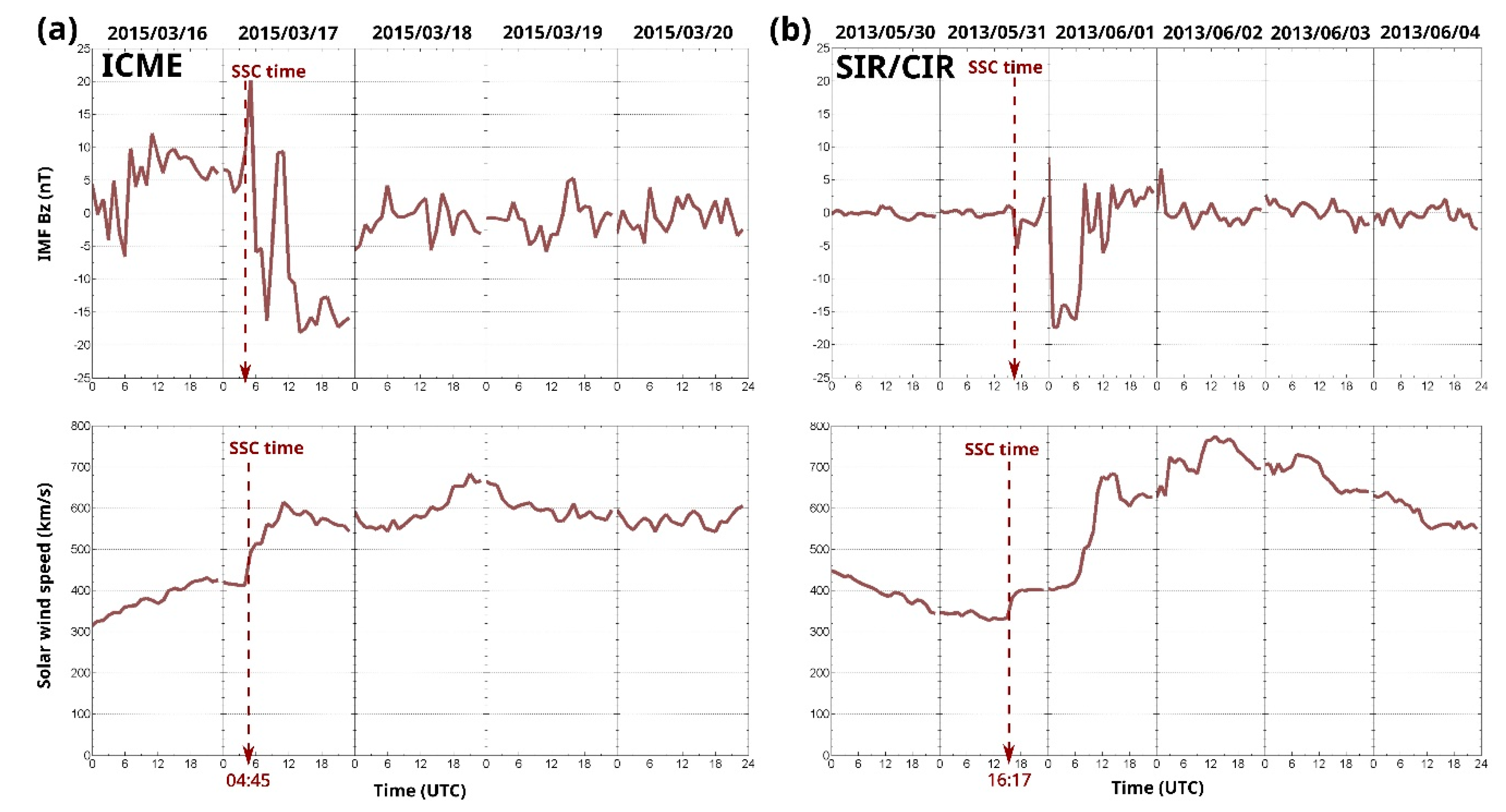
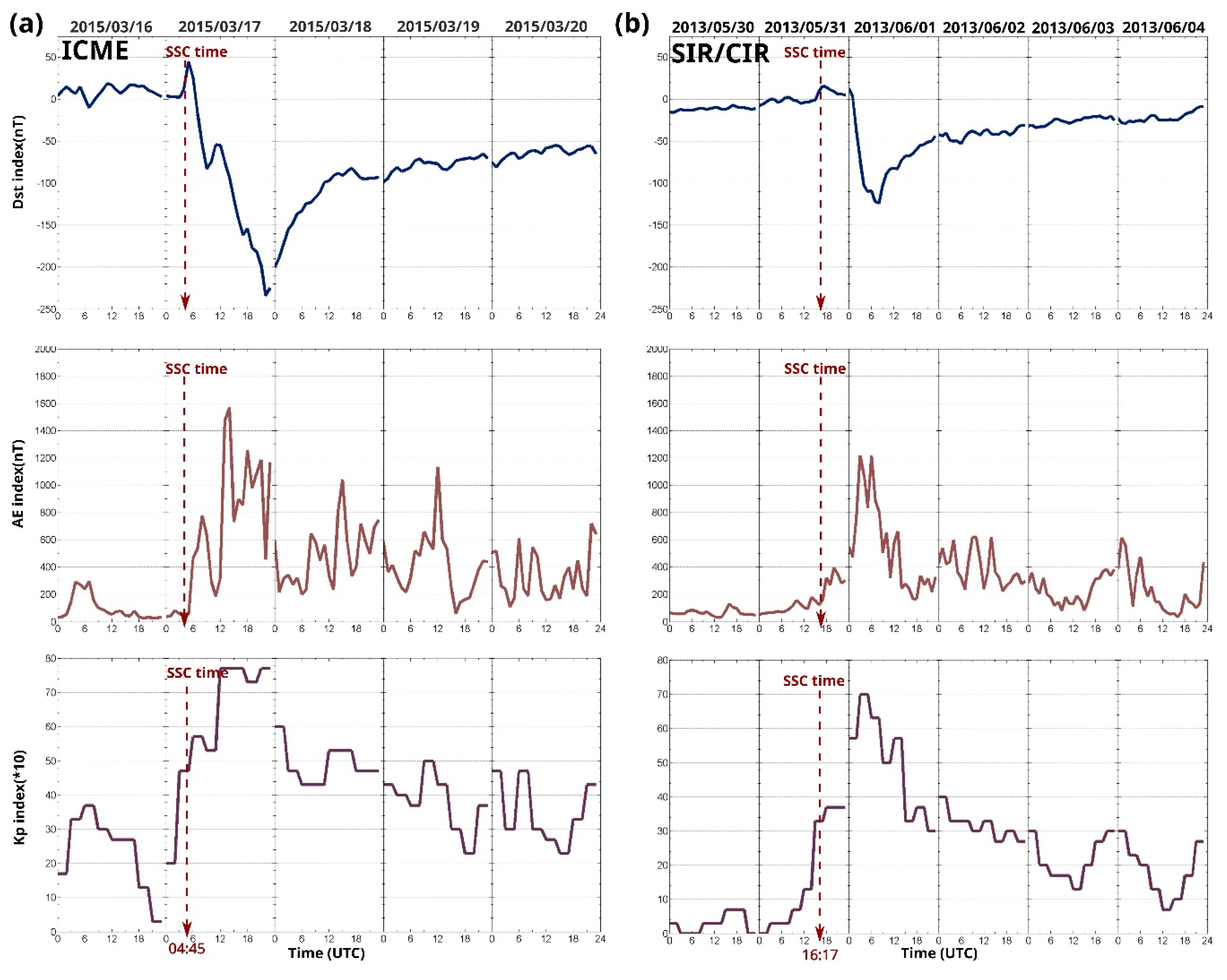
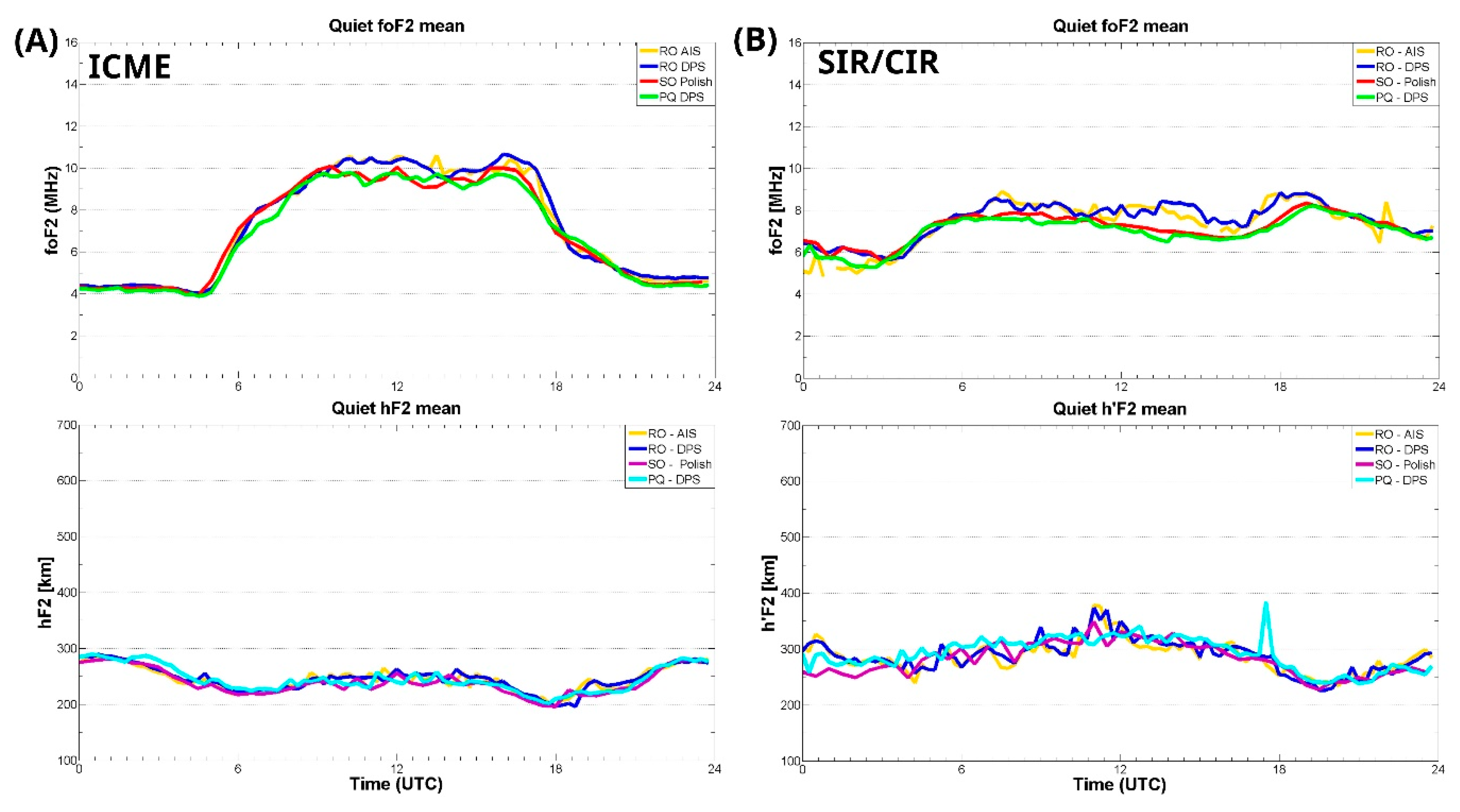
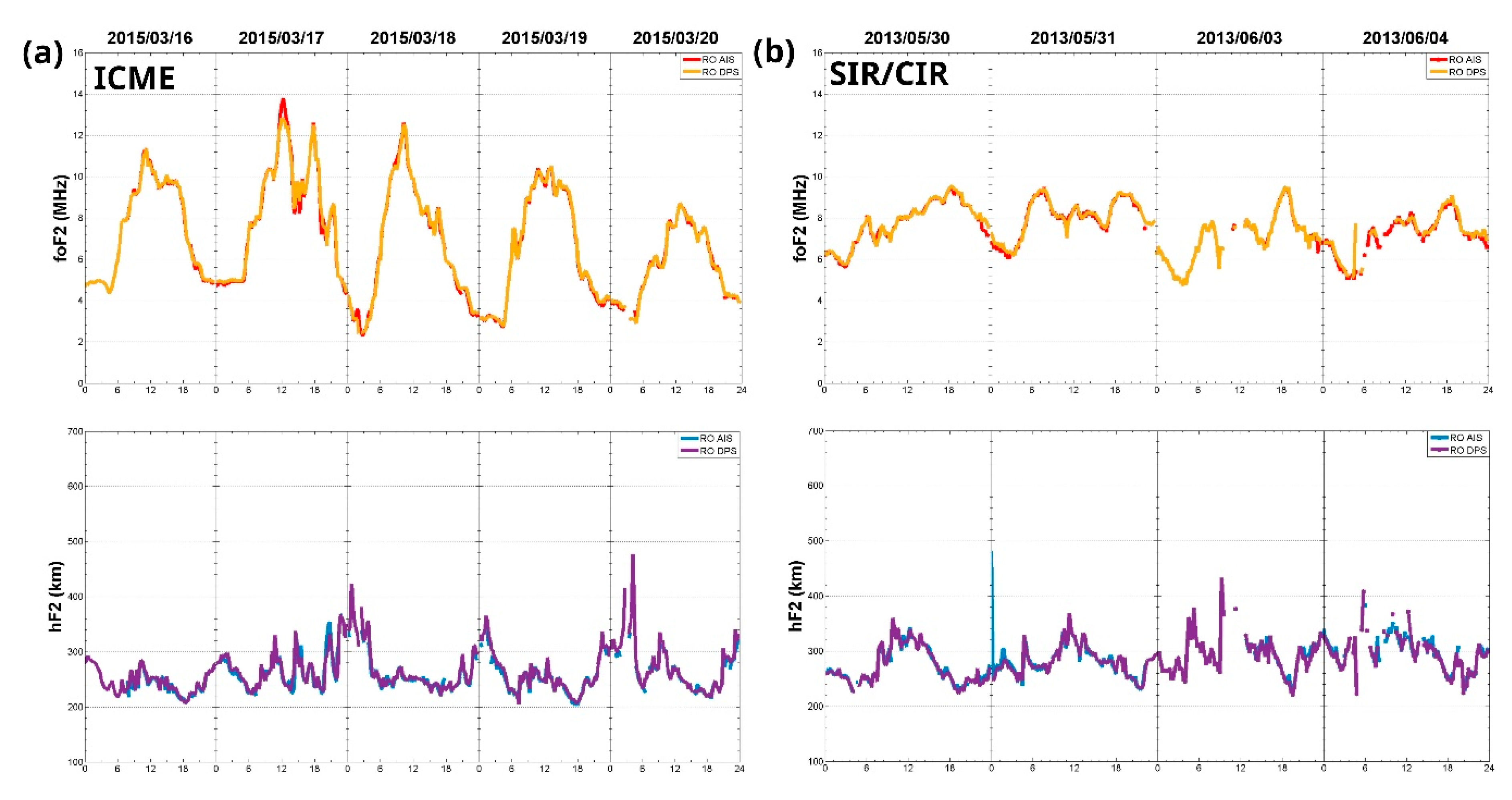
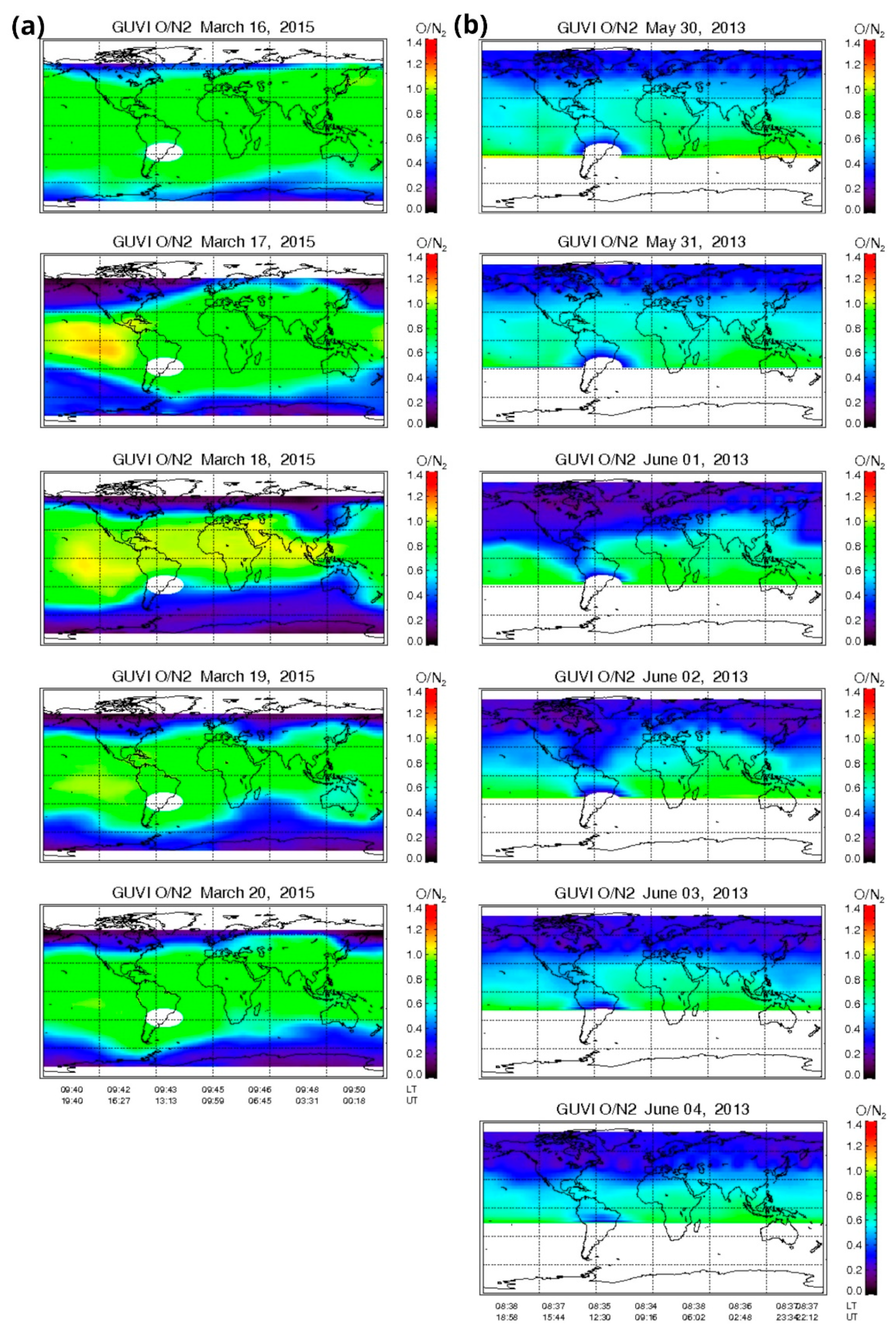
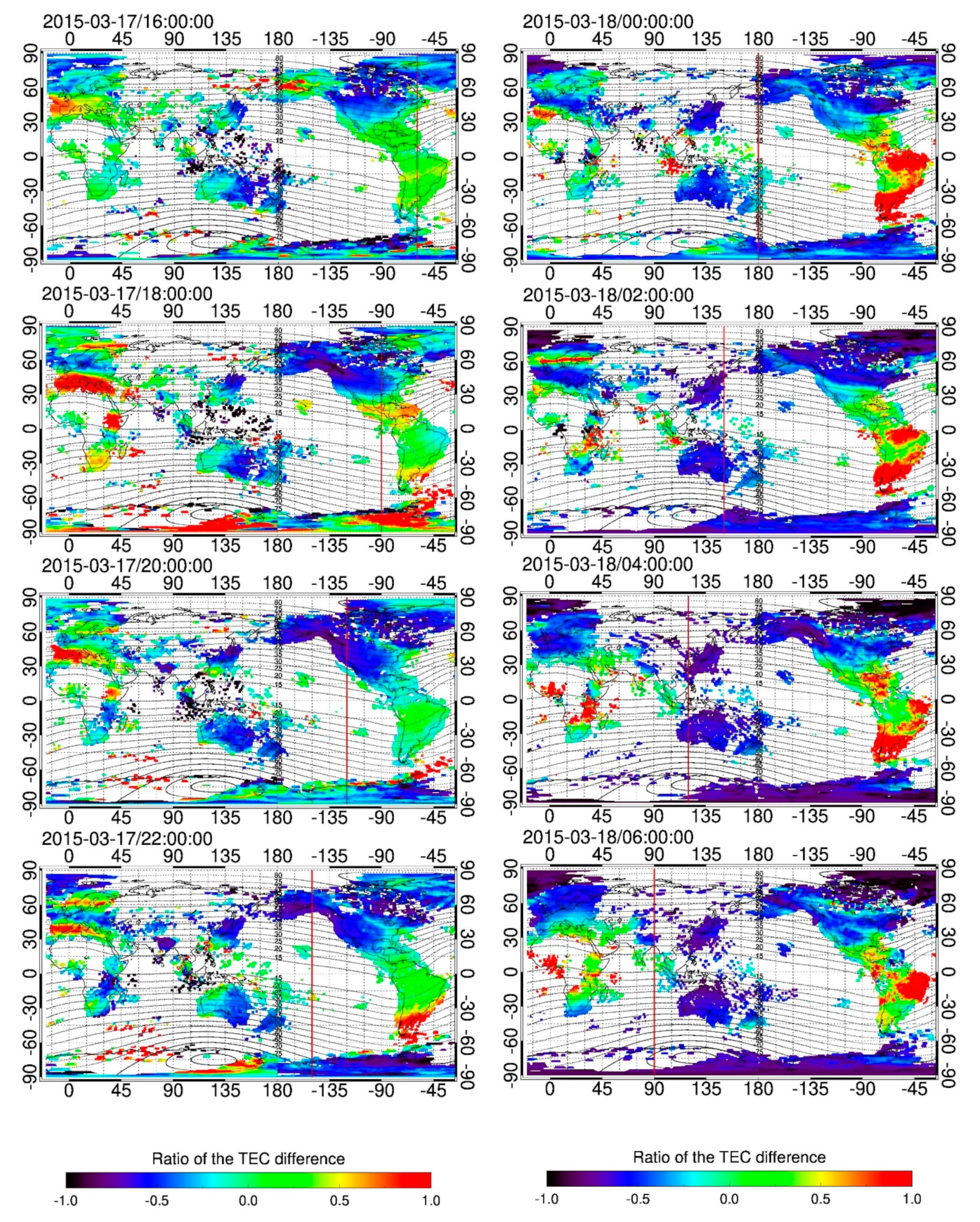
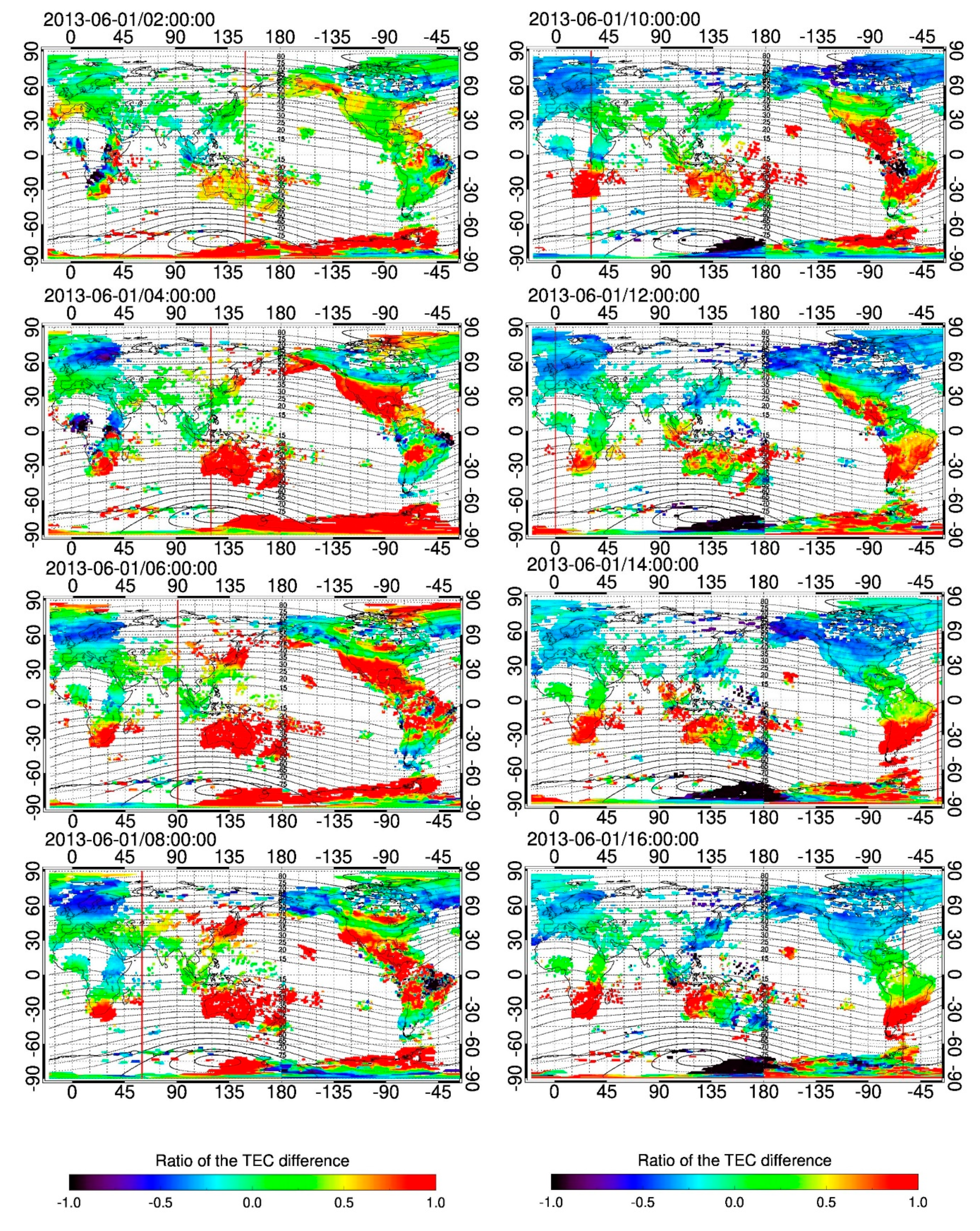
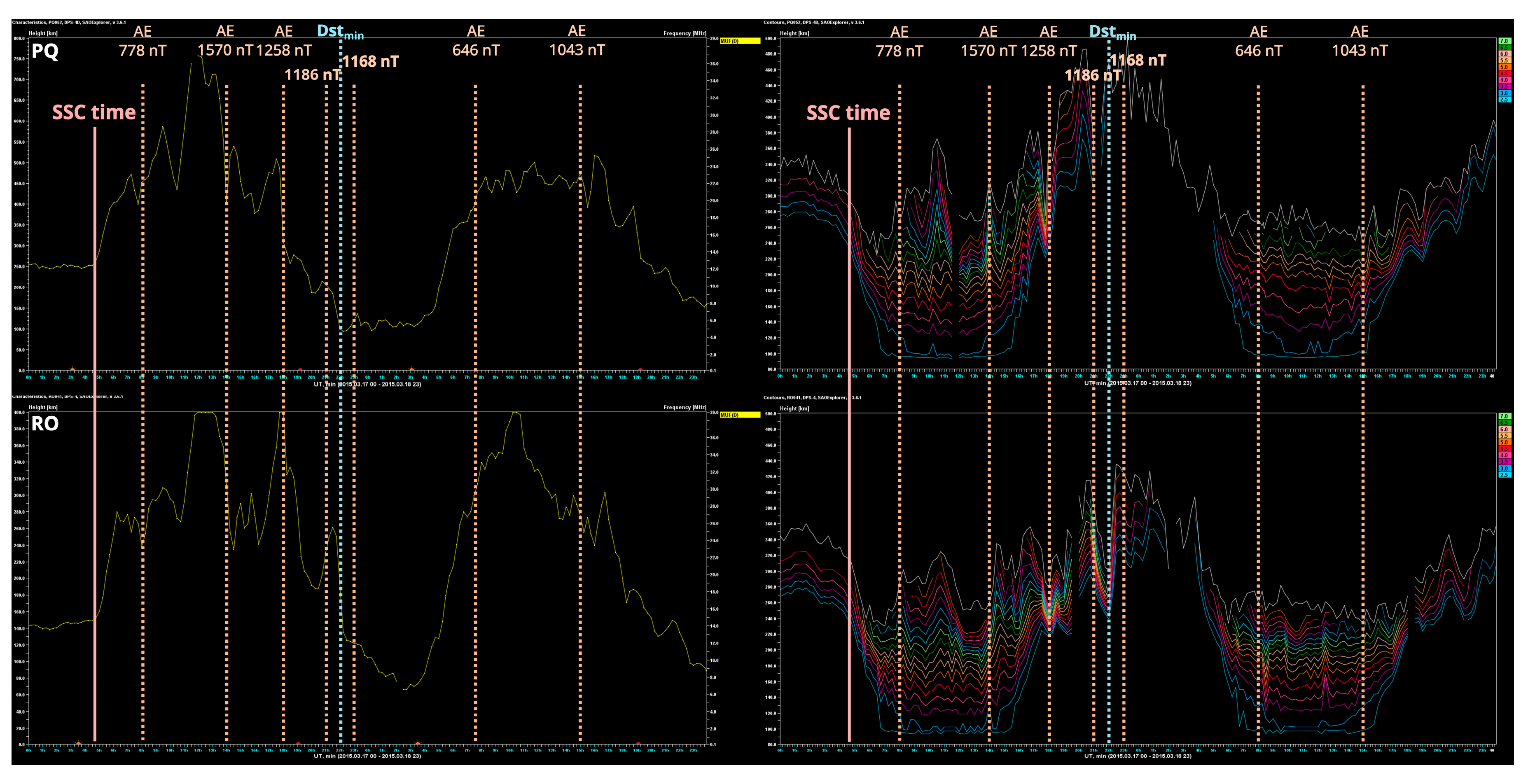
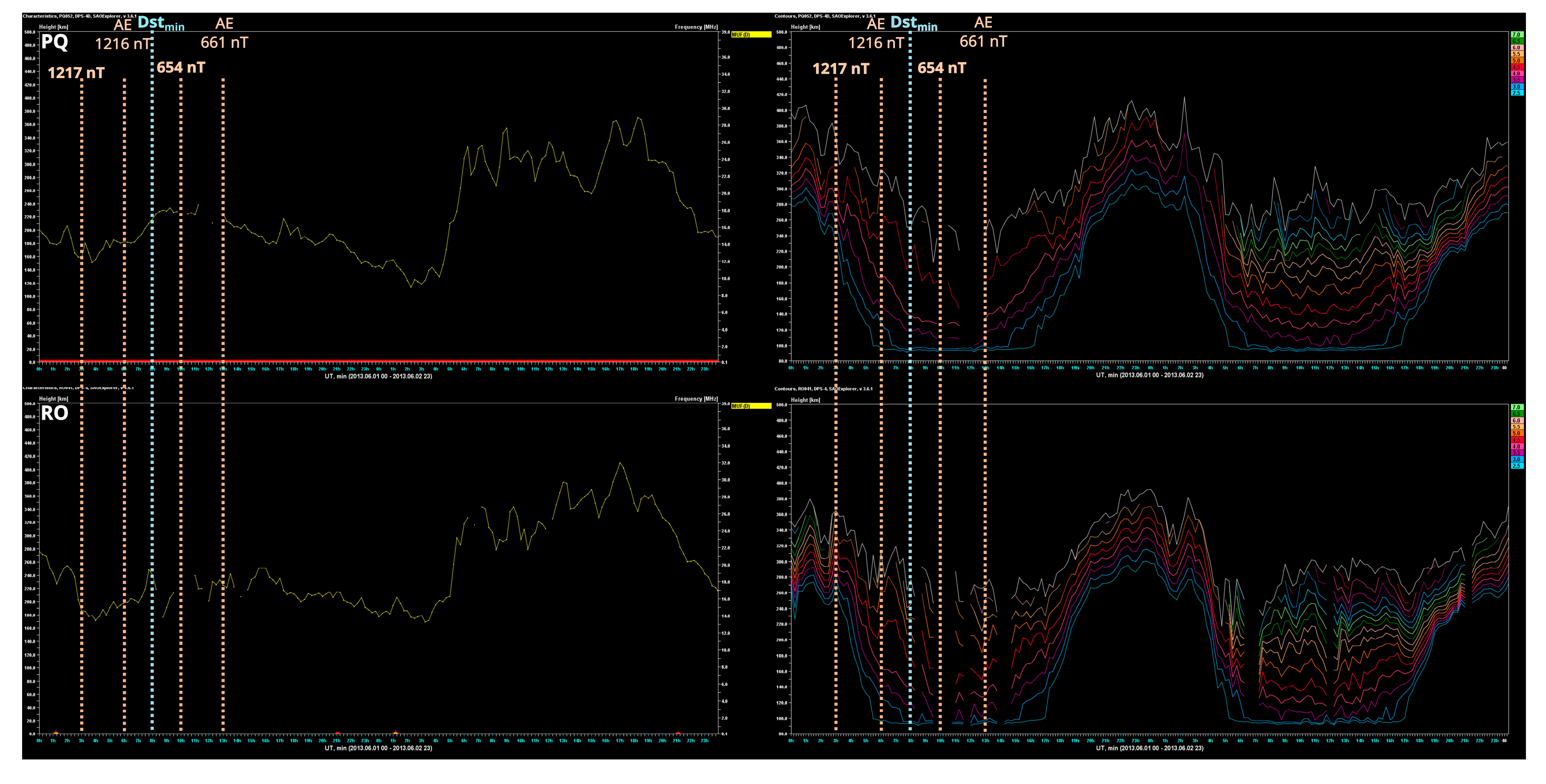
| Name of the station | Station ID (ionosonde type) | Geomagnetic Latitude (deg) | Geomagnetic Longitude (deg) | Geographic Latitude (deg) | Geographic Longitude (deg) | |
|---|---|---|---|---|---|---|
| Middle latitude | Pruhonice | PQ052 (DPS-4D) | 49.32° N | 98.61° E | 50° N | 14.6° E |
| Sopron | SO148 (VISRC-2) | 46.67° N | 99.75° E | 47.63° N | 16.72° E | |
| Low mid-latitude | Rome | RO041 (DPS-4) & RM041 (AIS-INGV) | 41.7° N | 93.76° E | 41.8° N | 12.5° E |
| ICME-related | Reference interval, Q-days (average of these 3 days will be the reference value) | SIR/CIR-related | Reference interval, Q-days (average of these 3 days will be the reference value) | ||||
|---|---|---|---|---|---|---|---|
| SSC date | Main phase | Studied interval | SSC date | Main phase | Studied interval | ||
| 17.03. 04:45 UT | 17.03.2015 (Kpmax=7,67, Dstmin=-223 nT) | 16.03-20.03.2015 | 10, 13, 14 March 2015 | 05.31. 16:17 UT | 01.06.2013 (Kpmax=7.00, Dstmin=-124 nT) | 30.05-04.06.2013 | 16,17, 26 June 2013 |
Disclaimer/Publisher’s Note: The statements, opinions and data contained in all publications are solely those of the individual author(s) and contributor(s) and not of MDPI and/or the editor(s). MDPI and/or the editor(s) disclaim responsibility for any injury to people or property resulting from any ideas, methods, instructions or products referred to in the content. |
© 2024 by the authors. Licensee MDPI, Basel, Switzerland. This article is an open access article distributed under the terms and conditions of the Creative Commons Attribution (CC BY) license (http://creativecommons.org/licenses/by/4.0/).





